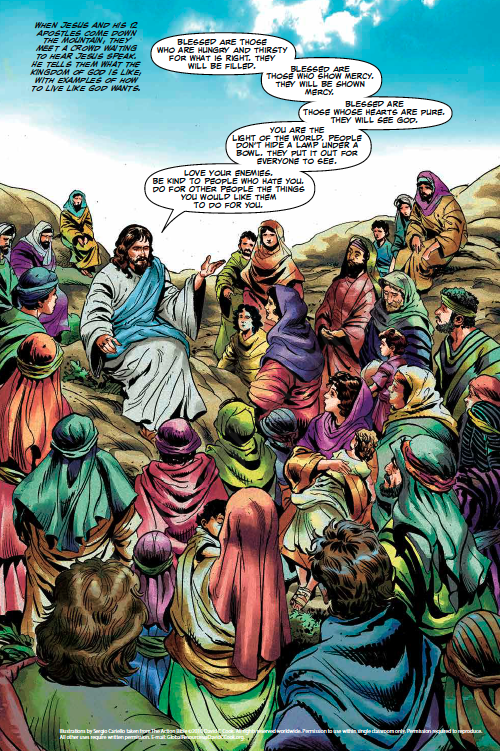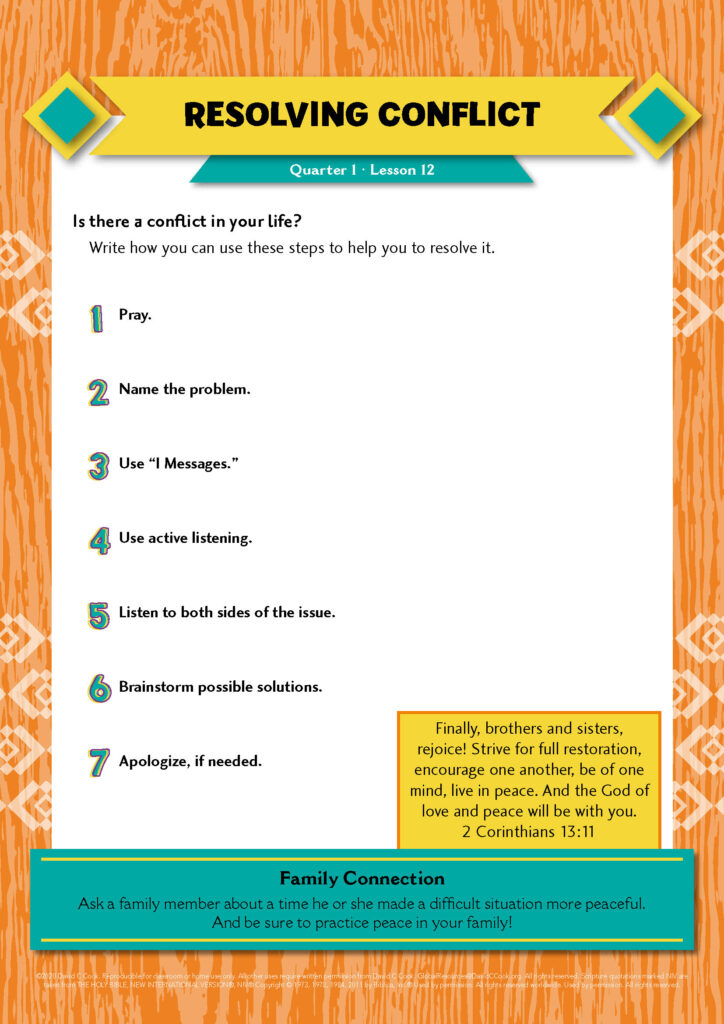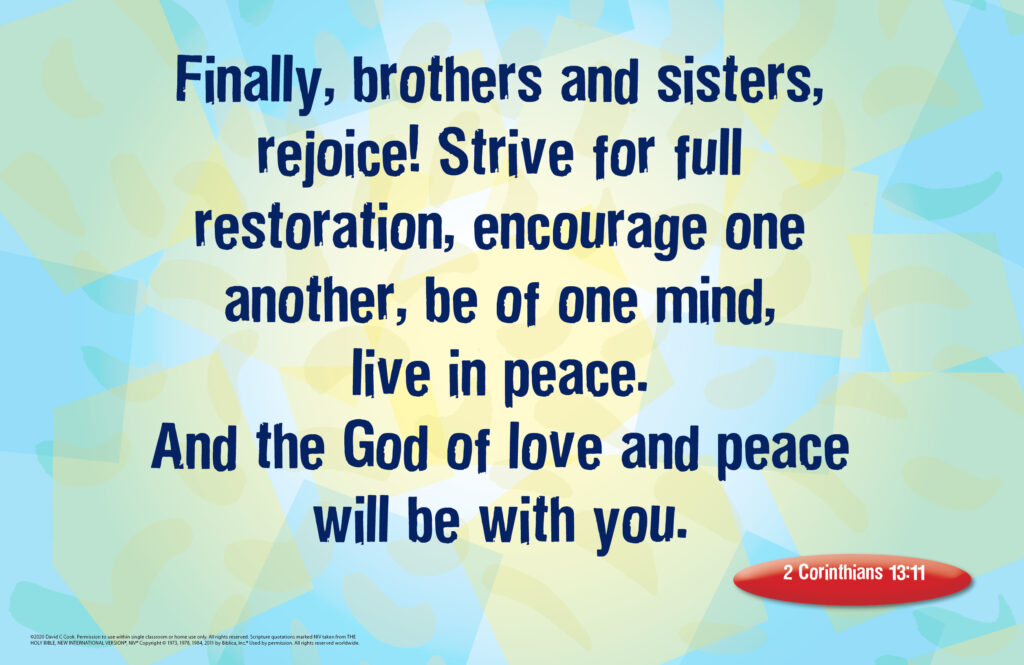During the lesson, the information for you to know is written in regular type, and what we suggest speaking or reading aloud to children is in bold. All resources for this lesson, including the Teacher Guide, Student Page, Family Connection Card, and other resources can be downloaded in a ZIP file by clicking on the following link:
In some lessons you will find "resource articles." These are articles written by experts from around the world to help equip you for your work with children and adolescents. Share them with parents or guardians if you consider it appropriate.
If it is possible, as far as it depends on you, live at peace with everyone.
Romans 12:18
Conflict is a part of our world. When a misunderstanding or wrongdoing occurs, someone takes offense, and emotions flare. Before you know it, there is a full-blown conflict. Even people who love God and are doing His work can experience conflict. Pause for a moment and consider if you have any unresolved conflicts in your life.
God wants us to resolve conflicts so we can experience peace. In order to do this, we need to fill ourselves with His love. With His help, we can love even those who have wronged us the most. Ask God to show you now the steps you can take to begin to resolve that conflict in your life so that you can live in peace. Trust Him and obey what He shows you.
Help your students understand that, while conflict is a natural part of life, God has given us a healthy way to deal with it. Many of them may have experienced painful conflicts, and many may be living with bitterness, hurt, and grief as a result. Practicing healthy conflict resolution will help your students experience giving and receiving forgiveness. It will also help them to build a lifelong habit of looking for solutions that promote peace and understanding. Pray that you and your students will follow God’s plan for conflict resolution.
Encourage the students to ask a family member about a time he or she made a difficult situation more peaceful. They can also practice peace in their own families.
Teacher Tip: If possible, email or text the Family Connection Card to the families of your students.
Today we will talk about resolving conflicts, but first let’s play a game.
Invite 2 students (either 2 boys or 2 girls) to sit on opposite sides of a desk or table or lay on their stomachs on a flat surface and arm wrestle. Encourage the rest of the class to cheer for both competitors. If you do not have a table and chairs the students can lie on their stomachs and put their elbows on the floor.
We will have an arm-wrestling competition. Our 2 competitors will clasp hands across the table. There are 3 simple rules to this game: your elbows must touch the table at all times, you cannot stand up, and you cannot use your other arm. When I say, “go,” try to push the other player’s arm until the back of his or her hand touches the table.
Let the students arm wrestle while the rest of the group cheers them on. Once there is a winner, ask for a volunteer to challenge the winner (have 2 boys or 2 girls compete). If you have the time, play several rounds.
Today we will talk about conflict. Conflict is when you have a disagreement or serious argument with someone. Sometimes a conflict can last for a long time. A conflict can feel a lot like arm wrestling. You go back and forth. Both of you are trying to push things so that they go your way. Let’s think of things that cause conflicts.
Anger is an emotion we all feel sometimes. Just like wind spreads a fire, anger can fuel a conflict. When you feel angry, it is easy to not think about how you are acting or what you are saying. You just react to what has upset you.
Sometimes you need to work out a problem with someone. But if both of you are angry, trying to resolve the conflict can be very difficult. Today we will hear some helpful ways to work out conflicts.
When Jesus began His ministry on earth, He travelled around the region of Galilee in the northern part of Israel. He preached the good news of God’s kingdom and healed people of all kinds of sicknesses and disabilities. The Bible says large crowds began to follow Jesus to be healed and to hear His teaching. One day, Jesus and His disciples went up onto a hillside, and Jesus began teaching the people. The words He said are found in Matthew 5—7. As Jesus was teaching, He told the people what to do if they became angry with one another.

Have a student read Matthew 5:23–24 aloud from the Bible.
Therefore, if you are offering your gift at the altar and there remember that your brother or sister has something against you, leave your gift there in front of the altar. First go and be reconciled to them; then come and offer your gift.
Matthew 5:23–24
In this verse, Jesus is talking about giving offerings to God. In the Jewish faith, people presented animal sacrifices at the temple. They placed their offerings on the altar as payment for their sins.
Possible answers might include: it affects all our relationships; it affects our relationship with God. If someone holds a grudge against you, you should try to resolve it as soon as possible.
Allow student to offer thoughts. Share the following, if they do not mention it: when we have conflict in our hearts, it affects our relationship with God. When we cannot work out things with someone we can see, how can we have a healthy relationship with God, whom we cannot see?
Jesus said it is important to resolve conflicts that we have with others—especially other Christians. He knows that the way for us to live in harmony with others is to practice kindness, understanding, and forgiveness. He also knows we cannot do this without His help.
Now we will talk about the steps to resolving conflict. Listen and see if you recognize any of these steps!
Explain the following steps of conflict resolution. If possible, write the steps on a whiteboard or large piece of paper.
Conflict Resolution Steps:
1. Pray.
2. Name the problem.
3. Use “I Messages.”
4. Use active listening.
5. Listen to both sides of the story. Respect the other person, even if you disagree.
6. Brainstorm possible solutions. Try to find a solution that benefits both people.
7 . Apologize, if needed.
The first step in resolving a conflict is to pray. God knows what is right. He knows what both people are feeling and thinking. He knows your needs. So pray and ask God to show you what to do to resolve the conflict. Let’s pause and pray right now.
Pray out loud for the children to hear the Spirit’s counsel and encouragement as they learn conflict resolution.
The second step is to name what the problem is. If you do not do this, 1 of you might think the problem is 1 thing while the other thinks it is something else. Sometimes sharing what each of you thinks the problem is can help you to realize that you do not have a problem at all.
The third step is to use “I Messages.”
Students may recall that “I Messages” help to communicate emotions and thoughts in a way that helps others to hear and understand. For example: “I feel_____ when _____ happens.”
When you share how you feel, do not use words such as “always” or “never” because people rarely do something all the time or not at all.
The fourth step is active listening.
Allow 2–3 students to share. Active listening involves showing respect, giving your full attention, listening with your ears and your heart, and responding with love.
Listen to this verse that helps us understand how to resolve conflict.
My dear brothers and sisters, take note of this: Everyone should be quick to listen, slow to speak and slow to become angry, because human anger does not produce the righteousness that God desires.
James 1:19–20
Careful listening helps us know what the other person needs and feels. If we are too angry or upset, it is hard to listen and really hear what the other person says.
Being slow to speak means you are taking time to listen instead of just reacting.
The fifth step is to listen to both sides of the story. Sometimes a conflict occurs because of a simple misunderstanding. Hearing both sides of a situation can solve many problems. Remember to respect the other person, even if you disagree with her.
The sixth step is to come up with several ideas for possible solutions. Even solutions that seem impossible or silly can help you resolve a conflict, so include them in your brainstorming! If nothing else, silly suggestions can make you both start laughing. Then you will be less angry, and you can talk with each other more calmly. The goal is to find a solution that benefits both of you.
Most conflicts have several possible solutions. Some solutions do not benefit either person. Some solutions only benefit 1 person. The best solutions benefit both people.
The solutions where neither person benefits are negative, so use 2 minus signs. The solutions where 1 person benefits and the other does not are positive and negative, so use a plus sign and a minus sign. The solutions where both people benefit are positive, so use 2 plus signs. Have your students discuss the different types of outcomes for the following situations. If you have time, you may want to divide your students into 4 groups and allow them to brainstorm different solutions.
Let’s talk about some conflicts and possible solutions to understand how to find different solutions.
Amos and Jonan are brothers. Their family owns 1 bicycle. Amos wants to use the bicycle to ride to his job each morning. Jonan wants to use the bicycle to do errands for the family after school. Each brother believes he deserves to use the bicycle. Listen as I read possible solutions to the conflict. After I give each solution, tell me who you think it benefits. It may be neither brother, only 1 brother, or both brothers.
Optional: Give the 2 pieces of paper with the plus and minus signs to 2 volunteers. The first volunteer is Jonan and the second volunteer is Amos. As you read the possible solutions, ask them to show the plus side if the solution benefits their character. They will show the minus sign if the solution does not benefit their character.
End of Option
– -: Neither boy uses the bicycle because they cannot decide how to share it.
– +: Jonan does the family errands by walking because Amos uses the bicycle to go to work.
+ –: Jonan uses the bicycle every day to do errands, so Amos walks to work.
+ +: The brothers create a schedule that allows them to share the bike. Jonan uses the bicycle for errands when Amos is not working.
Here is another scenario. The well for the village where Nadia and Justine live is a 15-minute walk down the hill from their home. It is dangerous to go there at night. Both girls worked very hard during the day and returned home late and thirsty. But there is only 1 cup of water left.
Turn to your neighbor and quickly share how you think the girls can solve their problem.
The final step in conflict resolution is to apologize if you need to. Sometimes, even though it seems like 1 person may have started the problem, both people need to apologize for things that happened during the conflict.
Learning to resolve our conflicts in a positive way takes practice. Let’s review our steps for resolving conflicts:
1. Pray.
2. Name the problem.
3. Use “I Messages.”
4. Use active listening.
5. Listen to both sides of the issue. Respect the other person, even if you disagree.
6. Brainstorm possible solutions. Try to find a solution that benefits both people.
7. Apologize, if needed.
Ask the students to pair up with friends. Read aloud 1 of the following conflict situations. Each partner will take a side in the conflict. Then the partners will practice the steps for resolving conflict. Remind them to try to come up with a solution that is positive for both people. Give the pairs about 5 minutes to decide how they will settle the conflict. Repeat this process for the second situation.
Situation 1
Side 1: It is family visiting day. Your father promised to visit. He did not come. You are very sad and hurt. You sit alone apart from everyone else. You do not want to pretend to be happy when you are not, and you are frustrated when your friend tries to talk to you.
Side 2: It is family visiting day. Your mother came to visit you. She brought you a sweet treat she had made. You spent the day together. You are happy and singing. You do not understand why your friend cannot be happy with you and will not talk to you.
Give the partners about 5 minutes to talk through solutions.
Situation 2
Side 1: You and your friend were playing with a football. You accidentally kicked it into a window and cracked it. When asked about it, you lied and said your friend had done it.
Side 2: You and your friend were kicking around a ball. Your friend accidentally kicked the ball into a window and cracked it. Your friend lied and said you had cracked the window.
Give the partners about 5 minutes to talk through solutions.
After the students have practiced resolving conflict with these 2 situations, ask them to think of situations from their own lives. The pairs can choose 1 of the situations and act out how they could resolve it. Then they can switch and act out a situation from the other partner. After giving them some time to act out their situations, gather the students back together as a group and discuss the following questions. Allow students to share their thoughts.
Optional: If you are using the Student Pages, the teens can use the pages to write or draw about conflicts they need to resolve in their own lives.

Resolving conflict is important to God. He wants His children to have unity and be at peace with one another. Jesus always treated others with kindness, compassion, respect, and understanding. Following His ways of problem-solving can help us to grow closer to Him and become more like Him. Treating others the way God would treat them honors and pleases Him. It also allows us to show His love to the world. Let me read you a verse from the Bible that talks about this.
Finally, brothers and sisters, rejoice! Strive for full restoration, encourage one another, be of one mind, live in peace. And the God of love and peace will be with you.
2 Corinthians 13:11

Our unity with one another and our love for each other stand out to those around us. When we seek to make peace when there is a misunderstanding or we are angry with someone, we help others to see that Jesus lives in us.
Close your time with a blessing over your students based on 2 Thessalonians 3:16:
Blessing: Now may the Lord of peace Himself give you peace at all times and in every way. The Lord be with all of you.
If you have time, continue to share this song with your students to celebrate how great God is!
Life on Life ©2020 David C Cook. Reproducible for home or classroom use only. All other uses require written permission from David C Cook [email protected]. All rights reserved.